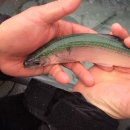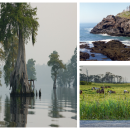Environmental DNA (eDNA) analysis is rapidly growing in its application for monitoring invasive species invasive species
An invasive species is any plant or animal that has spread or been introduced into a new area where they are, or could, cause harm to the environment, economy, or human, animal, or plant health. Their unwelcome presence can destroy ecosystems and cost millions of dollars.
Learn more about invasive species range expansions, and for helping to locate rare and endangered native species. The Center is working on the development and application of these methods for detecting DNA of aquatic species in the water. We have also developed genetic markers for several native species such as the American eel, dwarf wedgemussel, American shad, alewife, and blueback herring. And we have developed novel techniques for identifying multiple species in a single water sample to assess the community while also detecting invasive species. Our work is helping state and federal agencies with their early monitoring and detection of aquatic invasive species such as blue catfish, round goby and northern snakehead.
Invasive species management, Monitoring, Research




